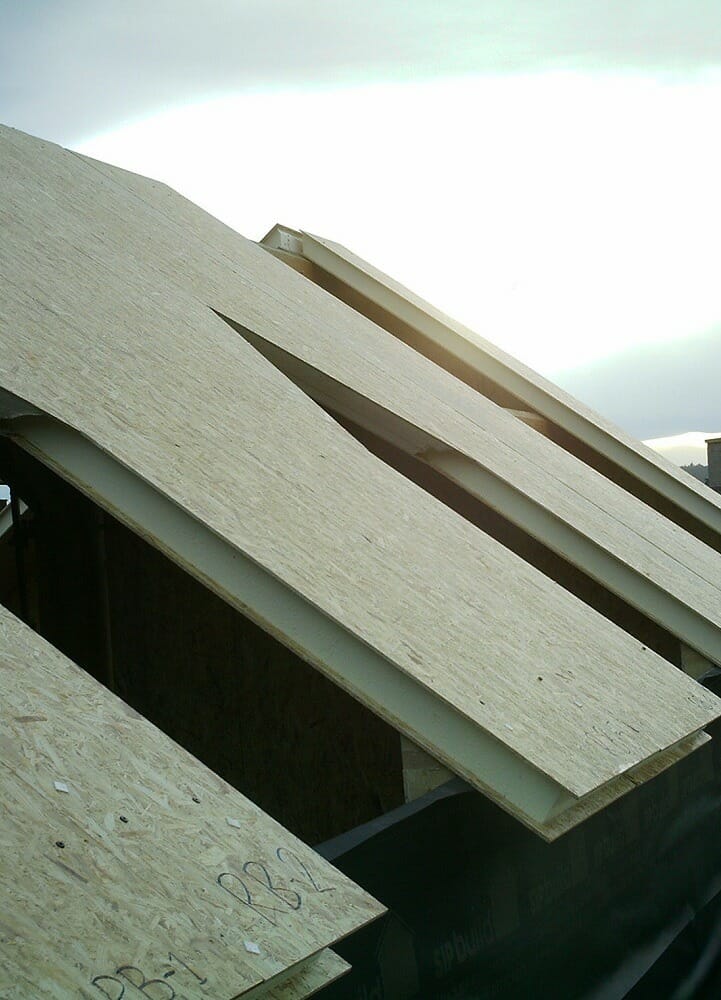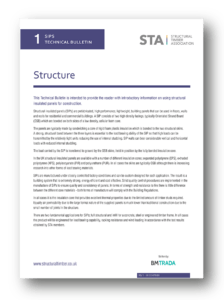SIPs are comprised of two high-density facings, typically Oriented Strand Board (OSB), which are auto-adhesively bonded to a low-density cellular foam core. This core includes rigid foam polyurethane (PUR) insulation, creating a robust structural bond between the layers. This bond is crucial for SIPs’ load-bearing capacity, allowing them to efficiently transmit high loads while reducing the need for internal studding.
SIP walls effectively bear both vertical and horizontal loads, with load transfer to the ground facilitated by the OSB skins secured in place by the insulation core.
Manufactured under tightly controlled factory conditions, SIPs can be custom-designed for a wide range of applications, resulting in a building system celebrated for its strength, energy efficiency, and cost-effectiveness. SIPCO upholds strict quality control procedures during production to ensure the consistent performance and quality of these panels.

- BS 5534 : 2003+A1: 2010 Code of practice for slating and tiling (including shingles)
- BS 5628-3 : 2005 Code of practice for BS EN 338 : 2009 Structural timber — Strength classes
- BS EN 594 : 1996 Timber structures – Test methods. Racking strength and stiffness of timber frame wall panels
- BS EN 846-6 : 2000 Methods of test for ancillary components for masonry — Determination of tensile and compressive load capacity and load displacement characteristics of wall ties (single end test)
- BS EN 1995-1-1 : 2004+A1: 2008 Eurocode 5 — Design of timber structures — General — Common rules and rules for buildings
- BS EN 1995-1-2 : 2004 Eurocode 5 — Design of timber structures — General — Structural fire design
- BS EN 1996-2 : 2006 Eurocode 6 — Design of masonry structures — Design considerations, selection of materials and execution of masonry the use of masonry — Materials and components, design and workmanship
Applications and Compliance with Standards:
SIPs serve two fundamental applications: full structural use and infill walling for concrete, steel, or engineered timber frames. In all cases, SIPs are meticulously engineered to meet rigorous load-bearing requirements, racking resistance, and wind loading standards, as stipulated within the SIPCO BBA certification.
Structural Strength and Testing
SIPCO panels are subjected to rigorous testing procedures to guarantee their exceptional performance. These tests include loading panels with a uniformly distributed load (UDL) to measure strength and deflection between two supports, axial loads placed centrally and eccentrically, racking loads, and shear and bending loads on the panel joints. The robustness of the joints between individual panels allows for potential spans over openings, supported by adjacent panels.
Tests have consistently demonstrated that SIPCO panels possess an exceptionally high ultimate bending strength. Deflection, as calculated according to our Design Guide, serves as the governing criterion in design, providing confidence that safe working loads comfortably exceed standard deflection limits.
The localised concentration of loading is achievable by incorporating additional timber at the panel joints. However, with careful detailing, much of this is avoidable. Tests have shown that the panels have a very high ultimate bending strength. Deflection, calculated as per our Design Guide, is the governing criterion in design. This increases user confidence that safe working loads are well over standard deflection limits.
Axial loading tests on panels, measuring 100mm in thickness, 2.4m in height, and 2.4m in width, have revealed impressive results. With a factor of safety of 2.0, panels comfortably support a vertical load of 90 kN/m, significantly surpassing the average foundation loading of a typical two-storey house constructed using traditional methods.







